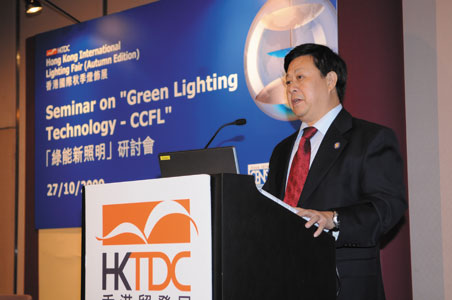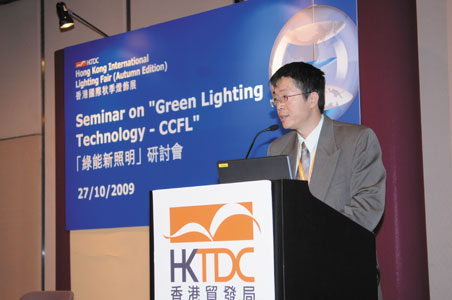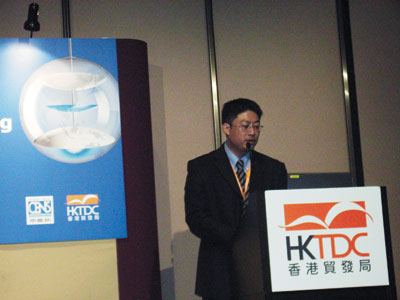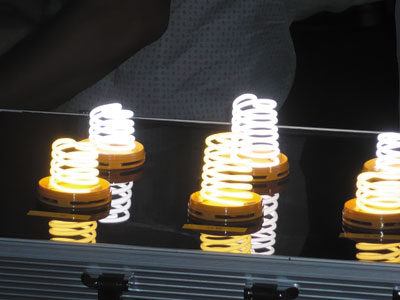Lighting Specialists Forecast CCFLs to Be Mainstream Before LEDs
Real-world examples and data offer
2010/01/13 | By Ken LiuAt a forum co-organized by the China Economic News Service (CENS) and Hong Kong Trade Development Council (HKTDC) during the Autumn edition of the Hong Kong International Lighting Fair 2009, held in late October, three lighting specialists from Taiwan and China agreed that cold cathode fluorescent lamps (CCFLs) will become mainstream before light emitting diodes (LED).

General Secretary of the China Illuminating Engineering Society S.P. Liu noted that CCFLs have been used as backlight in liquid-crystal display (LCD) panels since 1980, hence being a very mature lighting technology. But only till recently have such backlights been used for daily lighting "mostly because their gradual development has realized backlights in length and power in proportion to growing LCD panel sizes. Also a key progress is that the costs for such backlights have steadily fallen, alongside maturing manufacturing techniques, to make these lights practical," he said.

Liu's data confirm the developmental progress of CCFLs, with length having grown from only four centimeters initially to 150 centimeters, with drive power having been raised from 5W to 21W.

Promotion by Example
Liu says that many Taiwan-based tech enterprises have outfitted factories and offices in China with CCFL lighting equipment mostly imported from Taiwan, stressing that China has some CCFL factories but, due to inferior quality, can only turn out products for backlights. "Taiwan's manufacturers have introduced 90-lumen lamps whereas their mainland competitors are making ones only efficient enough for backlights, while Japan, Taiwan and South Korea dominate CCFL production and technologies," he says.

Liu says that CCFLs last 30,000 hours and withstanding one million on-off switches. Hot cathode fluorescent lamps (HCFLs) and compact fluorescent lamps (CFLs), he says, last 6,000 to 10,000 hours at the most and approximately 100,000 on-off switches. The specialist couldn't help to add science to the comparison: "HCFLs are less durable for they generate electrons differently than CCFLs. HCFLs heat up tungsten filament to give off electrons that collide with mercury gas to emit UV light. Such combustion depletes electrons on the filament, and the lamp expires upon total depletion of electrons." "Compared to HCFLs, CCFLs generate 'secondary' electrons by colliding gaseous cations with cathodes, hence minimizing radiation output," says Liu.
According to the secretary general, CCFLs are also excellent imitators of natural light, with high color rendering at 90 that nears natural light's 100. "Its color temperature ranges from the 2900K warm white to 7000K cold white, with the 5000K neutral white falling in between," he says.
Liu stresses that CCFLs are practical as energy-saving lamps for they are dimmable, with power-efficiency specs achievable provided that lighting systems are designed for illumination-output and electrical-power controls.
Offering Creative Freedom
In addition, CCFLs are compact, hence being favorites of lighting designers for the creative freedom offered.
Plus CCFL, Liu says, is eco-friendly given its near zero-mercury content inside glass tubes-with less than three milligrams of mercury solid and zero 313-nanometer radiation that can burn skin. His data also show that some HCFL lamps are still of Pb glass and contains more than 10 milligrams of Hg inside the tube as well as emit sun-tanning rays. "So CCFLs are superior to traditional fluorescent lamps with significantly minimized hazards," Liu says.
Liu's comparisons between CCFLs and LEDs show that, despite the latter being mercury and UV free, LEDS are still being developed and remain pricy. "Before LEDs fully become practical, CCFLs will have to replace incandescent bulbs and fluorescent lamps. Although still pricy compared with incandescent bulbs, energy saving lamps and fluorescent lamps, CCFLs enable consumers to recoup purchase prices in three months with reduced power bills," he beams.
Bright Lighting Market
Secretary General J.F. Huang of Taiwan' CCFL Lighting Alliance says that the global lighting market is estimated to grow from 2005's US$71.4 billion to US$90.4 billion by 2010, almost equaling the liquid crystal display (LCD) market. But, he stresses, the lighting market is more stable than the LCD market. "So we believe CCFLs will see steadier business when used as lighting than backlights," he says. The global CCFL market was battered by the financial crisis of 2008, which also racked the LCD TV segment worldwide. To better cope, Taiwan's CCFL makers have introduced lighting-type CCFLs.
Huang's data show that CCFL is 70% more energy efficient than T8 fluorescents and 48% more than T5 tubes, being rated at 32W vs. T8's 110W and T5's 62W. "CCFL produces around 173.8 kilograms of CO2 a year per unit, compared with T8's 597.4 kilograms a year and T5's 336.7 kilograms a year. Besides, CCFLs use, relative to the other two, the least glass for the tube body and contain the least mercury, as well as being recyclable," Huang stresses.
Other data show that a 32W CCFL lamp consumes only NT$1.536 of electricity over 12 hours, compared with NT$1.92 for a 40W LED lamp, NT$5.28 for a 110W T8 fluorescent lamp, and NT$2.976 for a 62W T5 lamp; so CCFLs certainly win as an energy-saver.
Huang says that Taiwan's CCFL industry leads the world in CCFL supply, with a one-third market share and production dominated by four major players-Wellypower Optronics, Delta Electronics, GIO Optoelectronics, and Sintronic Technology-making it easier to coordinate manufacturers to establish industry standards to go global; while Taiwan suppliers stand a better chance to build global brands, without competition from international players as OSRAM, Philips and GE in the CCFL lighting segment.
Huang says that Taiwan-based CCFL manufacturers have begun setting up footholds in markets and plan to launch products in stores worldwide in three to five years. "With help from the SMEA (Small and Medium Enterprise Administration) of the Ministry of Economic Affairs, domestic CCFL manufacturers organized an industry alliance to promote industry standards to go global," Huang says. "The alliance aims to develop general lighting products," he adds.
Huang says to foster formation of the CCFL lighting market, the alliance has been pushing for the enactment of industry standards by applying to the MOEA for review. "Once the standard is approved, we will promote CCFL lighting with manufacturers in China, South Korea and Japan," Huang says.
Another Advocate
George Lin, president of CCFL lighting fixture designer and distributor AUSSMAK Optoelectronics Corp., believes CCFLs will likely become mainstream three to eight years before LEDs mature in technology and acceptably priced. "That's because CCFL is durable, controllable in light intensity and low in hazardous mercury," Lin says.
Cashing in on CCFL's dimmablity, AUSSMAK has introduced stepless, dimmable CCFL lighting fixture and step-types. He says that although traditional fluorescent tubes and compact fluorescent lamps are also dimmable, such functionality usually shortens durability of the two lamps by 50% to 80%. "CCFL is free from such shortcoming and can work with off-the-shelf dimmers," he adds.
Lin's data show that LCD lamps outperform T5 and T8 lamps in luminous efficacy. An LCD grid lighting fixture with four T8-diameter CCFL lamps achieves luminous efficacy of 54.40 lumen-per-watt, compared with 44.67 lumen-per-watt with four T8 tubes, and 44.23 to 49.64 lumen-per-watt for a T5 lighting fixture with four tubes.
Responding to criticisms from LED makers that fluorescent lamps contain mercury, Lin says toxic hazards are also used to make LEDs, despite being free of mercury.

